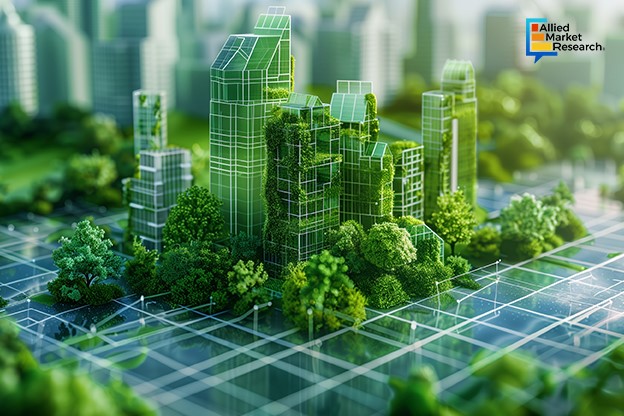Construction Sustainable Materials: How Have Green Building Practices Transformed the Industry?

18 Feb
2025
Highlights:
- Introduction
- Latest trends in the sector
- M&A deals in the construction sustainable materials market
Construction sustainable materials, as the name suggests, refers to eco-friendly raw materials used in building and construction activities. Ever since the declaration of net-zero goals under the Paris Climate Accords in 2015, several countries across the globe have taken serious steps to reduce the carbon footprint of their economy. New laws and rules have been passed in such nations which mandate polluting sectors such as manufacturing, construction, transportation, consumer goods, etc., to opt for materials and techniques that bring down the rate of greenhouse gas emissions. The renewability, reliability, and energy efficiency offered by these products make them perfect for small, medium-scale, and large residential and commercial spaces.
Use of innovative materials creating new investment opportunities
The most popularly used green construction raw materials are bamboo and recycled steel. Similar to wood, bamboo has proven to be a much more cost-effective option for building and architectural activities. The robustness and sturdiness offered by bamboo are mainly because of the axially running fibers that help it distribute the weight and load evenly. Further, compared to wood, bamboo’s renewability is quite high as it grows back within 3-5 years. Moreover, the biodegradable and anti-bacterial properties widen its applicability in the construction sector. Also, bamboo absorbs much more carbon dioxide than conventional timber which makes it the perfect raw material in contemporary times.
Similarly, the growing use of recycled steel has played an important role in reducing greenhouse gas emissions from the atmosphere. Recycled steel's resistance to water and pests enhances its suitability for buildings across all climates, significantly boosting its utility. Along with this, advancements in material sciences have helped companies develop innovative construction solutions that have minimal impact on the environment. In the recent past, mycelium has emerged as a popular alternative to polyurethane or fiberglass foam. Mycelium is a vegetative root-like structure of edible fungi that has a high strength-to-weight ratio and lower thermal conductivity than concrete. Hence, unlike conventional polyurethane materials that are synthetic and non-biodegradable, this bio-based insulation material is completely eco-friendly and sustainable.
Along with this, the use of modern additive manufacturing technologies such as 3D printing is expected to create numerous growth opportunities for the construction sustainable materials industry. This advanced concrete manufacturing method drastically cuts carbon emissions and waste compared to traditional techniques, promoting sustainability and efficient resource use. Recently, several leading concrete manufacturing companies have launched innovative cement varieties that bring down the rate of GHG emission by around 90%, thereby helping to decarbonize the construction sector.
M&A deals boosting the revenue share of the industry
The strategic alliances established by multinational businesses are expected to help the construction sustainable materials industry to gather a sum of $687.8 billion by 2033. The market accounted for $341.9 billion in 2023 and is estimated to rise at a CAGR of 7.4% during 2024-2033. In April 2024, Strabag SE, an Austrian construction company, announced that it had signed a definitive agreement to acquire Naporo Klima Dämmstoff, a major green building materials supplier. Over the years, Naporo Klima Dämmstoff has gained a reputation for its high-quality insulation panels made from hemp, flax, and other such biodegradable materials. Strabag has acquired a 100% stake in the company, which is expected to help the company expand its product portfolio in the coming period.
Similarly, in September 2024, Cemex, a Mexican multinational construction enterprise, announced the acquisition of RC-Baustoffe Berlin GmbH & Co. KG, a recycling services provider. As per the press release issued by Cemex, the strategic alliance is expected to boost the company’s circularity business. Fernando A. González, CEO of Cemex, highlighted that the construction and cement manufacturing sector account for 30% of global waste streams. The reintegration of these materials in the real estate development supply chain is thus expected to reduce a significant burden on the global ecosystem, thereby promoting sustainability. As per many industry experts, the strategic alliance aims to achieve this goal of environmental preservation in the long run.
In essence, the construction sustainable materials market is expected to boost its revenue share in the coming period owing to the increasing demand for green building projects. Furthermore, the growing use of eco-friendly raw materials such as bamboo and recycled steel is anticipated to create favorable conditions for the growth of the industry. The rising integration of advanced manufacturing techniques such as 3D printing is expected to strengthen the position of the sector in the coming period.
Contact our experts for the latest developments and upcoming trends in the landscape!

Akhilesh Prabhugaonkar
Author's Bio- Akhilesh Prabhugaonkar holds a bachelor’s degree in Electronics Engineering from the reputed Vishwakarma Institute of Technology. He has a special interest in the fields of forensics, world history, international relations and foreign policy, sports, agriculture, astronomy, security, and oceanography. An ardent bibliophile and melophile, Akhilesh loves to write on topics of his interest and various other societal issues. This love for writing made him enter the professional world of content writing and pursue his career in this direction.
Avenue: Entire Library membership of Allied Market Research Reports at your disposal
- Avenue is an innovative subscription-based online report database.
- Avail an online access to the entire library of syndicated reports on more than 2,000 niche industries and company profiles on more than 12,000 firms across 11 domains.
- A cost-effective model tailored for entrepreneurs, investors, and students & researchers at universities.
- Request customizations, suggest new reports, and avail analyst support as per your requirements.
- Get an access to the library of reports at any time from any device and anywhere.
Related Post
-
How are Submarine Cables Transforming Global Connectivity with Enhanced User Experience?
-
Endoscopy Procedures: Transformations in Techniques and Applications
-
AI-Powered Video Analytics: How the Product Actually Works for enterprises
-
Painting Robots: Transforming Precision Coating and Creative Applications
-
Innovations in Pharmacovigilance Systems Advancing Patient Safety
-
Understanding Edge Security: Keeping Data Safe Near the Source
-
Exploring the Use and Advancements of 3D Laser Scanners in Professional Applications
-
Reinforcing Industrial Controls with Smarter Tools and Training








